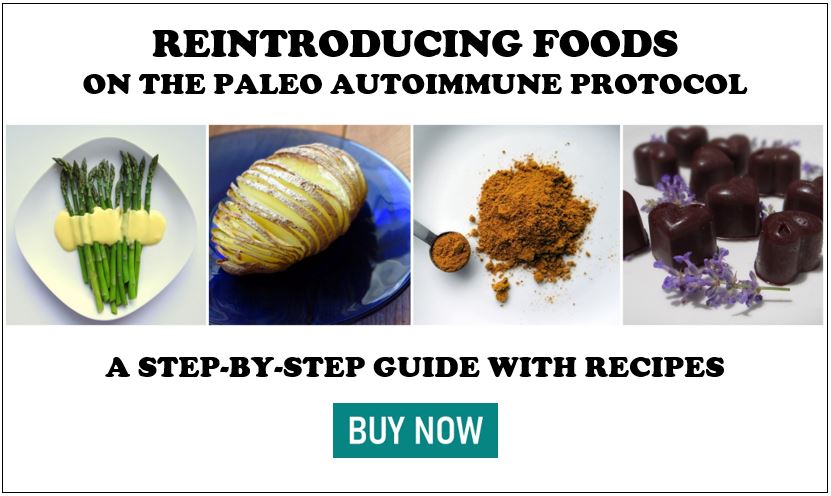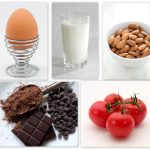“Knowing yourself is the beginning of all wisdom.”
~ Aristotle
This Interview Series
Reintroducing Foods on the Paleo Autoimmune Protocol was my first e-book, which I published back in 2014. I realized that the reintroduction process is often the trickiest part of the AIP journey. It can be confusing, overwhelming, and hard to navigate alone. I wrote the book to guide people through, and thereafter got a nickname: Reintro Goddess. (Just kidding, but wouldn’t that be a great nickname?) I’m passionate about this process for two reasons: (1) Some people make the mistake of thinking the elimination phase of the AIP is meant to last forever. It’s not. It’s just the first step. The next step is personalizing the diet for you. (2) The reintroduction process is an experiment with you at the center, where you learn to communicate clearly with your body, and it’s incredibly empowering! Everyone’s reintroduction experience is unique. I thought it would be inspiring and educational to interview people who have been through this process themselves.
Introducing Yael Goodman
Yael is the blogger behind Reversing Autoimmune. She has celiac disease, multiple sclerosis, and Hashimoto’s, and the paleo autoimmune protocol has been an essential part of her healing journey.
- How long did you do the elimination phase? This is tricky to answer as I started to reintroduce some things within a few months, and then when my health regressed I took many more months to try again, and I’m still trying some things out now, 4 years later! Which really is not the right way to do it but I discuss below why.
- How did you decide that you were ready for reintroductions? It was difficult to know when to start reintroducing things, but for me my stomach was the biggest indicator. I had really been struggling with ongoing chronic stomach issues and only when it felt like those had cleared up significantly, did I feel I was ready to properly try different foods.
- What foods have you been able to successfully reintroduce? Eggs, goat dairy, white rice, all nightshades, fresh legumes, white wine, nuts, and seeds (including chocolate and coffee). I haven’t yet tried gluten-free grains or dried legumes.
- Which ones can you eat regularly and which ones just occasionally? How did you discern the difference? I find this topic very interesting. When my gut was still not healed, I could only have small amounts of things that I had reintroduced, and I had to be careful not to overdo it. Now I can eat most things that I have reintroduced as often as I like. The exceptions are wine, seeds and fresh legumes. If I have too much, I get bloating and indigestion, so I limit those to occasionally and in small amounts.
- When food reintroductions failed, what were your symptoms? Depending on the food, usually gastric discomfort and an upset stomach. With eggs, initially I felt like I was going to faint and felt very weak, so that was odd. Sometimes other variables such as stress or medication changes make it difficult to tell. Eileen’s Editorial Note: I mention in my reintro guide that you want to choose your timing carefully for this reason – avoid high-stress times, and ideally medications should be stable.
- Did any reintroduction failures later become successes? Yes, eggs! I was so determined to be able to eat eggs. It was my number one goal. The reintroduction failed twice over a couple of years, but I worked hard at regulating my thyroid hormones, reducing stress, and fixing my gut. Then recently this last December, my reintroduction went so well that eating eggs not only doesn’t make me sick, they actually me feel good. (They are highly nutritious.)
- Have you reintroduced any non-paleo foods? If yes, which ones and how often do you eat them? Yes, I eat white rice quite regularly (initially mainly to try get my weight up) and some goat cheese occasionally. Only recently I have been able to go out and eat a gluten-free burger bun, or have some gluten-free biscuits, but it has taken me a long time to get to this point. I try and stay mainly paleo, though.
- Is there any food you’d never reintroduce? Yes, gluten until there is an alternative cure for celiac disease! I’m also reluctant to try cow dairy, as a genetic test revealed that I am also lactose intolerant. I’m also hesitant to eat dried legumes because I never tolerated them well before.
- What affects your food tolerance? The most difficult variable for me is my hormones. I have bad PMS and hormonal migraines (despite AIP). So, I make sure to avoid reintroductions around this time, as then I would not know if it was the food or my hormones causing the reaction. Stress also definitely affects food tolerance.
- Have you ever done an AIP reset (where you did the elimination phase over again)? If yes, what was the motivation, and did you find it helpful? Yes. After having felt so much better, I flared up very badly after going through a chelation protocol for heavy metals, that my body didn’t handle well. So I started AIP elimination all over again. Looking back now, I think that it would have been better to investigate for other infections in my gut; unfortunately the testing is very expensive. One of the biggest problems I see is that when people don’t get better, they remove more foods. That is what I did, but I don’t think that is the answer. That is the time to start looking for infections or other root causes. The thing that made the biggest difference to me and what has allowed me to eat most things now, was taking saccharomyces boulardii. It’s a beneficial yeast that can help in the treatment of SIBO and candida. It took me finding the right doctor to figure that out, and I think I stayed on an elimination diet for too long. Eileen’s Editorial Note: Supplements are very bio-individual. What is helpful to you might be different from what is helpful to Yael.
- Are there any foods allowed on the AIP that you discovered you don’t tolerate? Yes, many. Especially the sulfur-based foods, such as onion, garlic, cauliflower, etc. They are mainstays in AIP recipes, which made things quite difficult. I still can’t handle onion or garlic raw, but I can have a small amount cooked in dishes now without too much reaction. Also, I couldn’t handle too much fiber or high FODMAP foods for a very long time, but the S. Boulardii, I mentioned above also helped me with this issue.
- What was the hardest part for you about the reintroduction process? Definitely not knowing if something is a food-related reaction or not. It is difficult if there are other variables, so I needed to be very patient and do it slowly over time.
- What’s your advice for people contemplating reintros, or just starting their own reintroduction journey? My biggest advice is not to wait too long to reintroduce foods. Do the elimination until you are feeling a lot better and then start reintroducing foods. If you aren’t getting better, don’t take out more foods, go and see a functional medicine doctor and get tested for any infections or parasites, etc. Working on gut healing can rapidly expand food tolerance. And finally remember that is not only about food. Reduce stress, get enough sleep and exercise, and work on relaxation techniques, too.
One Last Word of Advice
Each person’s food reintroductions are unique, so don’t expect your results to be the same as above, even if you share the diagnosis. It’s fun to learn about each other’s experiences and be encouraged by them, but this is all about learning to listen to your own body. Use the resources below to learn how to do the reintroduction process yourself.
Paleo AIP Reintroduction Resources










